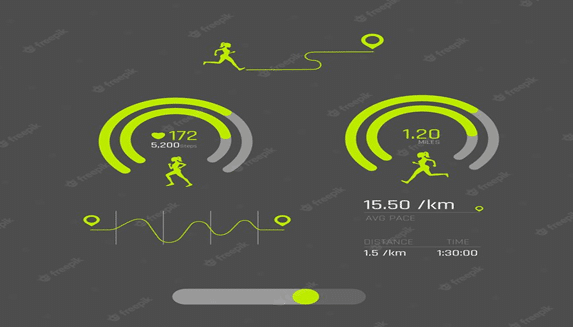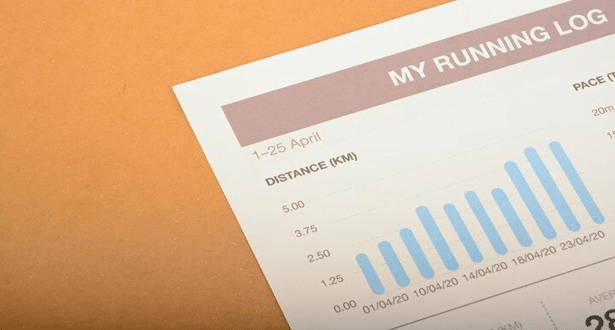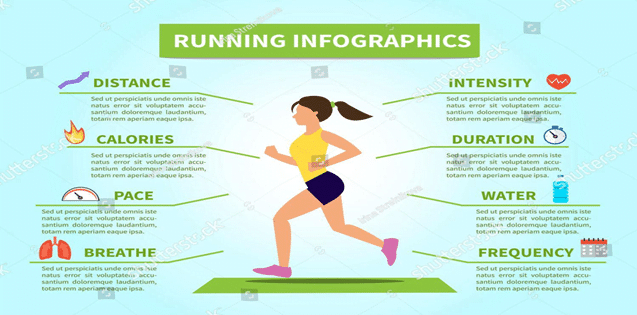Are you looking for a running pace chart for any level? We’ve got you covered. Whether you’re training for a 5K, 10K, half marathon, or marathon, you can find your pace here.
Using a pace chart, you can see your target mile pace and what time you should strive for at each 5K marker if, for example, you want to finish a marathon in under 4 hours.
The half marathon pace chart is helpful for interval training and race preparation. You may use the chart to show your mile splits for each mile of a speed exercise, such as a tempo run done at the pace you want to achieve in a 10K race.
Conversely, if you have a target mile pace but not a target race pace, you may use a race distance calculator to estimate your finishing time.
What Exactly is a Running Pace Chart?
A pace chart may calculate the average speed over a certain distance. You may want to use a pace chart to see how long it will take you to run 13.1 miles if you’ve been averaging 9-minute miles throughout your training runs.
If you follow the half marathon pace chart, you’ll know that if you run 13.1 miles in that time, you’ll cross the finish line in 1 hour, 57 minutes, and 54 seconds.
It’s worth remembering that the adrenaline you’ll feel on race day might push you to go faster than you ever have on your weekly long runs.
A pace predictor may help determine whether you’re on track to finish the race in the allotted time.
How Can an Individual Use a Running Pace Chart?

If you know your target finish time for the race, you may use the chart to determine your pace at each intermediate distance.
To finish a marathon in under four hours, you’ll need to average a pace of around 9 minutes and 15 seconds for each mile. To determine your target race time, locate the mile on the chart and read off the first time.
Using the running pace table, you can specify that you must finish a 5K in 24 minutes and 51 seconds if you wish to maintain an eight-minute mile pace.
To determine your target pace for speed exercises like tempo runs, locate your 10K race pace on the chart.
The chart also displays your mile pace, two-mile pace, and five-kilometer speed, which might be helpful if you’re preparing for shorter events.
Remember that the timings on the running pace tables assume a constant speed over the whole distance. Your pace might change in races and workouts due to factors including hills, other runners, the weather, and other environmental factors.
However, pace charts may help you stay on track by providing an average mile time to work towards. If you want to complete a race in a certain amount of time, a half marathon pace chart will tell you how fast you must be going throughout training.
How to Calculate Your Running Pace Using a Running Pace Chart?

Although it’s natural to compare your pace to that of other runners, it’s important to remember that your optimal training pace may be different from theirs. Your perfect running speed may require experimentation, even if you use a pacing guide throughout training.
You won’t be able to keep up with the online averages in pace while you’re just starting. Athletes can’t just jump into elite-level pacing since their bodies can’t adjust to the variety of speeds straight away.
However, estimating your pace from the beginning may be challenging, but using a chart that gauges typical paces for your level of training might be helpful.
Numerous sources have determined standard tempo zones for various forms of exercise. If, for instance, the chart assumes a 5k distance of 26 minutes, then it may need to be more accurate.
Then, different kinds of running exercises are associated with different average pace ranges in this section.
You may test out these approximate pace timings to see how they fit into your training, although there’s something you need to think about first.
Ways to Improve Your Running Pace

If you find the marathon pace chart findings discouraging, setting a goal to increase your pace might help. It’s possible that making specific changes may assist you in speeding up.
- Make your posture better: When your breathing is more efficient due to good walking form, you’ll be able to walk more quickly and for longer distances.
- Keep your arms bent: Your fast walking rate may be considerably increased by including the appropriate arm motion while you are walking.
- Utilize the correct stepping technique: Increase your speed by taking shorter, more decisive steps from heel to toe or by adopting the race-walking method of keeping your legs slightly straighter.
- Experiment with a run/walk method: If you need more time to complete the whole thing or want to cover more ground quickly, try alternating between running and walking.
Whether you’re moderately new to the sport or have years of experience, everyone wants to improve running speed in competition and beat their personal best.
You can improve your speed if you are a runner. Specific methods of training will need to be developed.
- Improve your stride turnover: Boosting your running speed requires increasing your steps each minute. Improve your running efficiency by taking short, sharp steps.
- Include interval training: Interval training is a great way to boost your stamina and cardiovascular fitness.
- Begin hill training: Repeatedly climbing a hill is a great way to improve your physical fitness, speed, your mental toughness, and your self-assurance.
- Rest and heal: Due to the body’s ability to heal itself during rest and recovery, it’s possible to get better results during successive efforts.
Assessing the Running Pace Chart and Ideal Mark for Each Level
You’ve put in much time and effort to prepare for this event. There is just a week left till the competition. Now is the time to develop a thorough marathon training plan using a pace chart that provides a realistic shot at finishing in your target time.
You should be aware of a few things to prevent any unpleasant shocks when competing. Here is a checklist to ensure you’ve thought of everything before the big race.
1. Training and Race Pace Chart

You should aim for around four or five sessions in the week leading up to the event. One of them is a burst-based, high-velocity interval training session.
The speed is comparable to a tempo run, with an MHR of about 85%-90%. Another option is short runs of 40-50 minutes at your goal race pace. The other exercise is jogging at a slow speed.
Create a race-pacing plan, along with a strategy based on the half marathon pace chart, and divide the distance into 5K segments.
Even splits are the most secure option for the pacing plan. In this section, you run each split at the same speed.
Positivistic splits are another viable option. The second part of the race is completed at a slower pace than the first.
To achieve negative splits, you must start the race at a quicker pace than you plan to finish it. If this happens, weariness sets in, and performance drops significantly in the second half.
2. Achieve Your Race Goal

Get yourself a powerful fitness app and utilize it to its full potential. You may enter your best time for a certain distance into the program.
For instance, you may train for a 5K or 10K. After you provide this data, the software will estimate your completion time for various distances. Now, compare your training times to the target time for your race.
Check your training log and the marathon pace chart to determine how fast you ran each of your long-distance runs.
Follow this plan if it corresponds to the anticipated speed. If that’s true, slow down to your newly determined average speed.
You will have a better chance of keeping up with the pace during the event if you have trained at the target speed for your longest runs.
Use your target pace on one of your runs over the following few days to prepare your legs to go that fast. Alter your training to get you into race mode, whether that means increasing or decreasing your heart rate.
3. Know the Ideal Mark for All Levels

Carefully examine the course topographical map and determine the half marathon pace chart. While doing so, look for and evaluate the prevalence and severity of slopes.
For instance, in a marathon, which is around 42 kilometers long, you must know whether you will face an 8% elevation at the 38-kilometer point.
At this moment, weariness may set in, making it difficult to move, or perhaps impossible, on a steep slope. Examine the route’s layout with the same critical eye.
Find out if the course is a loop, an out-and-back, or the finish line is in the same place as the beginning.
4. Maintain the Pace

Remember that your race speed will be roughly five to seven seconds per km slower for the first three to five kilometers. This will allow your muscles to loosen up and start your blood pumping.
You may quickly recover from the race’s poor start if you maintain a steady pace throughout the remaining kilometers.
The next step is to map out where the steeper sections of the route are and how much time will be needed to reach each one.
Now, consider your nutrition and hydration method to anticipate when you’ll need to consume carbohydrates, proteins, and fats in food and fluids.
Definitive Reasons Why to Use the Running Pace Chart

We have detailed a comprehensive viewpoint on the relevance and significance of the Running Pace Chart and its usage value.
However, there are a few reasons that perfectly define the value and why you must use it for monitoring personal growth in your journey as a professional runner:
- To determine an appropriate pace for running.
- You have determined your pace in minutes per mile for a training run.
- It helps you prepare for a race by setting a target time.
- Calculating how long it should take to go a certain distance.
- You can locate a buddy participating in the race you are running.
- Attaching one to your arm while participating in a lengthy run or race will allow you to monitor your performance more efficiently.
Effective Tips to Deal with Race Pacing for Beginners

A carefully planned marathon pacing strategy is a compass, allowing you to stay on course and ward off any burnout from hasty pace choices.
Create a custom pace strategy that fits your race objectives and fitness level with this guide:
- Establish your target pace: Find out how fast you need to run each mile or km to reach your goal in the allotted time using a half marathon pace chart. Your target pace is the basis for your whole pacing plan, whether you are trying to achieve a personal best, finish the race, or meet qualification times for another event.
- Divide the race into sections: Break up the marathon into smaller, more manageable sections, say, every 5 kilometers (or miles). Determine the intended split timings for each section depending on the desired pace. This method keeps you from getting caught up in the enormity of the race as a whole and lets you concentrate on completing each leg.
- Set a diet and hydration schedule: Set a time for when you will refuel and drink fluids, and if necessary, slow down a little to allow for these pauses.
- Focus on your breath: If you must work to catch your breath, you must slow down for a little while. Running steadily necessitates breathing in for three or four steps and then breathing out for the same number of strides.
- Dress appropriately: Uncomfortable footwear or apparel may be fatal to a fast racing time. Your goal should be to choose racing-friendly running shoes that are as lightweight as possible while providing enough cushioning. And wear technical running clothes made to keep you dry, comfortable, and unencumbered.
- Practice your pace strategy: Long runs are a great opportunity to put your pacing strategy to the test. Learn to maintain your target pace using a half marathon pace chart and run according to your sector splits.This training improves your physical resilience, willpower, and self-control.
Conclusion
The correct form and regular practice might help you run or walk faster. An accurate estimation of your total performance may be obtained using a pace calculator.
Remember that these are estimates, and your actual times may vary greatly depending on the course, the weather, and other factors. Your daily pace will be affected by a variety of other variables.
However, a half marathon running chart can help you track your progress during every run.
Also, a running chart can be helpful to achieve your target goals, determine the approximate running pace, strategize your running pace and distance, etc.
Above, we have covered what a running pace chart is, how it works, and more. So, incorporate the pace chart into your running routine and make your practice more effective.
Frequently Asked Questions
What is the Correct Way to Use a Pace Chart?
You may use the chart to determine how much time you must have at each mile of the race based on your target finish time. If you want to finish a marathon in under four hours, you’ll need to average a little less than a 9:15-minute mile pace.
How to Read a Running Pace Structure?
The first column shows the minute pace per kilometer (min/km). Every runner uses pace as a point of comparison. The equivalent speeds in kilometers per hour (kph), miles per hour (mph), and minutes per mile (min/mi) are listed in columns 2, 3, and 4, respectively.
What is the Ideal Method to Calculate the Running Pace Zone?
Finding your threshold speed is the first step in developing your running pace zones. You may take the time from a recent race of any distance up to a half marathon or complete a time trial on your own. Remember that your threshold speed is the fastest pace you can maintain for a continuous hour.




